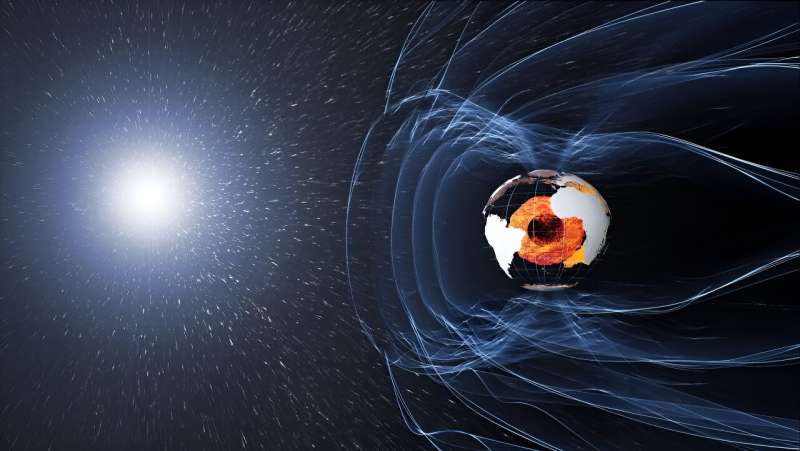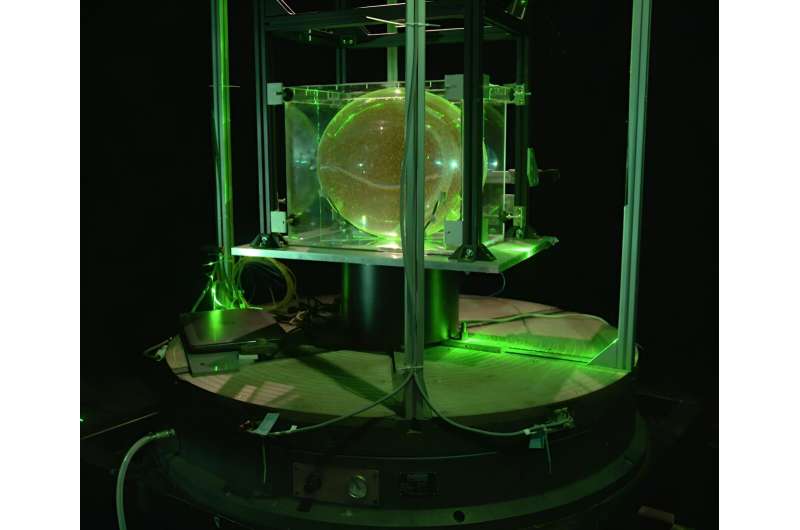This article has been reviewed according to Science X's editorial process and policies. Editors have highlighted the following attributes while ensuring the content's credibility:
fact-checked
trusted source
proofread
Earth's core, replete with oceans and cyclones, is being demystified

At the center of Earth is a vast ball of metal, the planet's core. While unreachable without the help of Jules Verne, it can be studied and plays a vital role for the world.
The iron-nickel interior generates a magnetic field that protects the planet from harmful radiation and allows life to flourish. Exactly how this magnetic field is created, and whether it is the same on other worlds, are open questions.
Iron oceans
New research is revealing more about planetary cores and magnetic fields than ever before—and hinting at changes that take place 3,000 kilometers under people's feet.
Earth has a solid inner core about 1,200 km across, surrounded by a liquid iron outer core that extends another 2,200 km. In the outer core, as the liquid metal circulates it generates a magnetic field.
"We're trying to understand the dynamics of the big iron oceans that are present in planets like Earth," said Michael Le Bars of the French National Center for Scientific Research, or CNRS. "The flow in there is responsible for the magnetic field of the planets. And this magnetic field is one of the key ingredients for life."
Le Bars studied these matters as part of a European project that received EU funding to spur advances in the field including through laboratory experiments. Called FLUDYCO, the initiative ran from mid-2016 until the end of 2021.
In labs, Le Bars and his team injected dye into a water-filled rubber ball and then rotated it to deform the sphere, simulating tidal distortions in Earth's core.
They also popped a balloon containing a liquid metal called Galinstan inside water to simulate the formation of a planetary core. Finally, the researchers tracked the interaction of lower and higher density water to study the convection and turbulence of an outer core.
The team found that there were three ways to drive circulation inside a liquid iron core.
Worldly ways
The first was by metallic iron swirling in the outer core. This process, called convection, results from the cooling and solidifying of the planet's core.
Another method was tidal forces caused by the gravitational push and pull of a nearby object—perhaps like the magnetic moon Ganymede, which orbits Jupiter and is named after a Trojan prince in Greek mythology.
The third involved crystals of solidified iron forming in the liquid outer core and driving the circulation, a reverse of the solidification happening in Earth's core.
"It's snowing iron ice crystals towards the inside and mixing the fluid," Le Bars, Marseille-based director of research at CNRS, said of the third method. "It's a very strange process."
What remains unclear is exactly which worlds would have which method to produce their metallic fields or whether other processes might be involved for gas giants like Jupiter.
"Each planet seems to be different," said Le Bars. "We don't know if Ganymede's core is convecting or snowing."
A European spacecraft launched in April 2023 and due to reach Jupiter in 2031 will orbit Ganymede and could produce revelations about its core, perhaps helping to ascertain how worlds like this generate a magnetic field.
In Earth's solar system, Saturn, Uranus and Neptune also have substantial magnetic fields.
Orbit observation
Another way to investigate planetary cores is to make indirect measurements of them.

An EU-funded project called CoreSat has been doing this from orbit by using three European Space Agency satellites that study changes in Earth's magnetic field.
The initiative, due to wrap up in August 2023 after five and a half years, is led by Chris Finlay of the National Space Institute at the Technical University of Denmark near Copenhagen.
Earth's magnetic field can strengthen and weaken, altering its structure including the locations of the magnetic poles by tens of kilometers a year, or sometimes even flip in polarity entirely—something thought to happen every few 100,000 years or so.
Finlay says the satellites are showing how the magnetic field is changing.
Using data from the satellites, Finlay and his colleagues have been seeking a clearer picture of the magnetic field at the boundary between Earth's lower mantle and the outer core.
Magnetic signal
A major difficulty has been picking out the magnetic field signal from the core among the other magnetic fields produced at and above Earth's surface.
One technique has been to monitor Earth's upper atmosphere and its aurora at the poles and identify a cleaner signature of changes in the core's magnetic field.
The goal is to have systems that can predict how the magnetic field is going to change over the coming decades, according to Finlay.
"It's been challenging," he said. "We'd like to do something like in weather forecasting, where they have models of the general circulation of the atmosphere and make forecasts."
Studying changes in the core's magnetic field is important for understanding the habitability of Earth and other worlds.
Nowhere are these changes more noticeable than in the South Atlantic region.
Underground hurricanes
Off the coast of South America, Earth's magnetic field weakens more than 50%.
While the cause of this phenomenon known as the South Atlantic Anomaly is unknown, projects like CoreSat are providing additional information.
"We've been able to see more details," Finlay said. "We're still working on it."
It appears that, down at the boundary of the core and mantle underneath the anomaly, the magnetic field is reversed.
That could be a sign of weather-like systems in the outer core caused by temperature differences and the rotation of the planet.
"In the same way you get cyclones and hurricanes in the atmosphere, we also have that happening in Earth's core," said Finlay. "This organizes the convections into large circulations in the outer core."
That said, the swirling inside Earth occurs at much slower speeds—20 km a year compared with wind velocities of up to 250 km an hour in hurricanes.
Even with the advances in research, there is much still to learn about planetary interiors and the implications are broad.
"Today we are looking at other planets to find life on them," said Le Bars of CNRS. "To have life, you need a magnetic field to protect the planet."
Provided by Horizon: The EU Research & Innovation Magazine




















